Sambar (Spicy Lentil Soup)
Sambar is a flavorful spicy South Indian lentil soup made with a variety of vegetables. It fits nicely with many South Indian meals, including dosas (pancakes), idlis (savory cakes), and rice. It could be said that a South Indian meal is incomplete without sambar.
- 1/2 cup toor dal/arhar dal available in any Indian grocery store
- 1/2 tbsp salt
- 1/4 tbsp turmeric (haldi)
- 2 tbsp oil
- 1/2 tbsp cumin seeds (jeera)
- 1/8 tbsp fenugreek seed (methi)
- 1/4 tbsp mustard seeds (rai)
- Pinch of asafetida (hing)
- 10-12 curry leaves
- 4 dry whole red chilies
- 1 large tomato cubed in small pieces
- 1-½ cups mixed vegetables, cute into bite-size cubes (green beans, carrots, zucchini, radishes)
- 2 tbsp tamarind pulp
- 1/2 tbsp salt
- 1 tbsp sambar powder, available in any Indian grocery store
Wash and soak the dal in two cups of water for ten minutes or longer.
In a pressure cooker combine soaked dal with 2½ cups of water, salt, and turmeric. Cook over medium high heat.
When the pressure cooker starts to steam, reduce the heat to medium and cook for another six minutes.
Turn off the heat and wait until steam has escaped before opening the pressure cooker. Dal should be soft and mushy.
Mix the dal well enough to remove lumps. If the dal is thick, add up to one cup of water.
Prepare Seasoning
- Heat the oil in a saucepan. Test the heat by adding one cumin seed to the oil; if it cracks immediately, the oil is ready.
- Add cumin seeds, mustard seeds, fenugreek seeds, asafetida, red chilies, and curry leaves. Stir for a few seconds.
- Add tomatoes, vegetables, sambar powder, tamarind pulp and ½ cup water.
- Cover the pan and let the vegetables cook until they are tender over medium heat.
- Combine the vegetables and the dal to make the Sambar. Sambar should be thin, like soup. If the sambar is thick, add water as needed.
- Cook sambar on low heat for 10-15 minutes.
Serve Sambar with dosa, idli, rice or with any meal as a side.
How to make Sambar Masala: Sambar Recipe
Sambar is a quintessential South Indian dish that holds a cherished place in Indian cuisine. This sambar recipe is a delightful combination of sambar dal, vegetables, and aromatic spices, creating a flavorful and nutritious sambar masala. In this comprehensive guide, we'll explore how to make sambar step by step, incorporating tips, variations, and benefits to elevate your culinary experience.
Tips for Perfecting Your Sambar Recipe
- Use Fresh Ingredients: Opt for fresh spices, vegetables, and lentils to ensure the best flavor and texture in your sambar.
- Balance the Flavors: Adjust the proportions of tamarind paste, jaggery, and salt to achieve the perfect balance of sour, sweet, and savoury notes in your sambar.
- Experiment with Vegetables: Don't hesitate to experiment with different combinations of vegetables to create unique variations of sambar tailored to your liking.
- Temper with Care: Take care not to burn the spices while tempering, as it can impart a bitter taste to the sambar. Maintain medium heat and keep a close eye on the tempering process.
- Allow for Resting Time: Let the sambar rest for a few minutes after cooking to allow the flavors to develop fully before serving.
Variations of Sambar
- Mixed Vegetable Sambar: Incorporate a medley of seasonal vegetables such as pumpkin, beans, and bell peppers for a colorful and nutritious twist on the classic sambar.
- Tiffin Sambar: Prepare a thinner version of sambar specifically paired with idli, dosa, or vada, featuring a lighter consistency and a higher proportion of tamarind for tanginess.
- Kadamba Sambar: This variation of sambar includes a diverse range of vegetables along with freshly ground spices, lending it a robust and hearty character ideal for special occasions.
Benefits of Including Sambar in Your Diet
- Rich in Protein: Sambar is a rich source of protein due to the inclusion of lentils, making it a nourishing option for vegetarians and vegans.
- Loaded with Vitamins and Minerals: The array of vegetables in sambar provides essential vitamins, minerals, and dietary fibre, promoting overall health and well-being.
- Digestive Aid: The spices and herbs in sambar, such as cumin, fenugreek, and curry leaves, possess digestive properties that aid in digestion and alleviate digestive discomfort.
- Low in Calories: Despite its hearty and satisfying nature, sambar is relatively low in calories, making it a guilt-free indulgence for those watching their calorie intake.
- Boosts Immunity: The antioxidants present in the spices and vegetables in sambar help strengthen the immune system and protect the body against various infections and diseases.
FAQs (Frequently Asked Questions) About Sambar
-
Can I make sambar without tamarind paste?
- Yes, you can substitute tamarind paste with lemon juice or dried mango powder (amchur) for a tangy flavor in your sambar.
-
Is sambar gluten-free?
- Yes, sambar is naturally gluten-free as long as no wheat-based ingredients such as asafoetida powder (hing) are used in the recipe. You can use gluten-free asafoetida or omit it altogether to ensure the dish is gluten-free.
-
Can I make sambar ahead of time?
- Yes, you can prepare sambar in advance and store it in an airtight container in the refrigerator for up to 2-3 days. Reheat gently on the stovetop or microwave before serving.
-
Can I freeze leftover sambar?
- While it's technically possible to freeze leftover sambar, the texture of the vegetables and lentils may change upon thawing, resulting in a slightly altered consistency. It's best to consume fresh sambar for optimal taste and texture.
If you're looking to explore more Indian recipes, appetizers, beverages, and desserts, be sure to check out the following links on Manjula's Kitchen. Here are some links to recipes on Manjula's Kitchen official website: Vegetable Pakoras, Kaju Katli (Cashew Burfi), Baingan Bharta (Roasted Eggplant), Matar (Green Peas) Paneer, Besan Ladoo.
Comments
Leave a CommentComment policy: We love comments and appreciate the time that readers spend to share ideas and give feedback. However, all comments are manually moderated and those deemed to be spam or solely promotional will be deleted.
Leave a Reply
You must be logged in to post a comment.

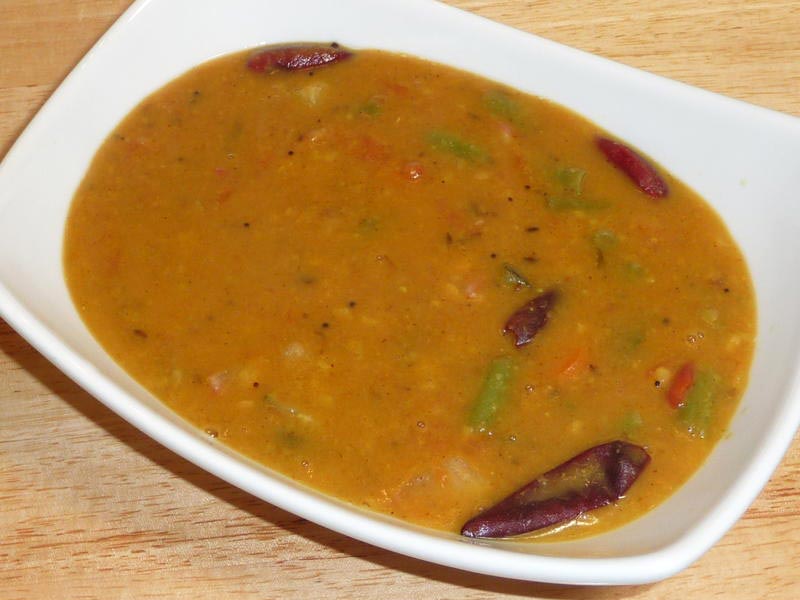
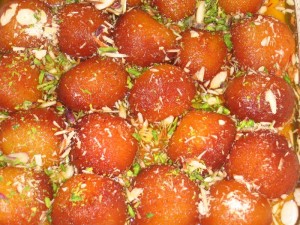
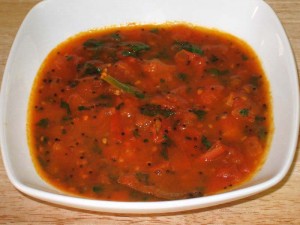
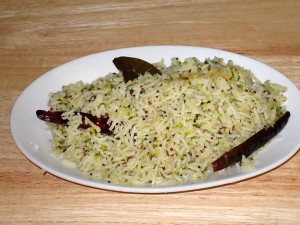
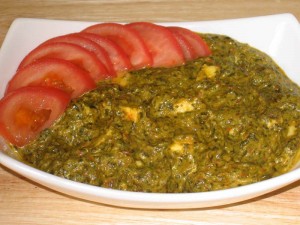
Maria Carlton
July 24, 2016 at 9:53 amI love your videos. Is Rassam powder the same as Sambar powder? Please advise. Thank you for all these wonderful recipes.
Manjula Jain
July 25, 2016 at 11:44 pmMaria, they both are different and both available in Indian grocery store
madhuri
July 29, 2015 at 5:59 amexcellent recipes, thanks .
rehmut
July 21, 2015 at 12:42 pmCan you store samba in the freezer, I am looking for gravy that i can prepare at home for work and put in the freezer to serve with fresh rice. any pointers?
Manjula Jain
July 22, 2015 at 4:46 pmrehmut, check out any of my gravy base dish, like matart paneer, shahi paneer, malai kofta any of these gravies freeze well and they can be used with different vegetables.
Stacey
June 11, 2015 at 5:27 pmI love your recipes, I’ve always wanted to learn Indian cuisine
Manjula Jain
June 15, 2015 at 10:52 pmStacey, hope I am helping.
George Carey
May 20, 2015 at 11:02 amThis sambar recipe is one of my favorites. It does take some extra time to make the tamarind paste but I like making it myself rather than using the ready-made kind.
I’ve tried different vegetables for some variety, my favorites are corn, green beans, peas and carrots. Little pieces of cauliflower are also delicious.
I always make a big batch of sambar so I can enjoy it for a while!
Thank you so much for the recipe!
plasterer bristol
April 7, 2015 at 1:53 ambeen looking for a nice recipe of this to try. Thanks for sharing this.
Simon
Sara Jane
January 10, 2015 at 8:52 amNamaste and thank you. I have made many of of your recipes for my satsang group. Today I made this sambar and it is so delicious and healing.
siqilla
October 28, 2014 at 5:03 amHi Manjula!just few words to thank you for your website and these delicious recipes, I’m not Indian and before to find your website I thought Indian recipes are too difficult for me, Alhamdulillah I found out this beautiful website and whatever I’ve tried it has always been successful (I’ve already tried your chickpeas rice, masala zucchini, cucumber salad, sambar, masala tea, palak paneer) thank you so so so so much!!!!
SomeOne
June 17, 2014 at 4:22 pmCan I add onions to the Sambar. What is the receipe??
Ashok
June 4, 2014 at 2:52 amHey Manjula,
I tried making sambar today, it came out perfect thanks to sambar powder and your instructions
Sambar with Rava Dosa | The Spunky Veggie
July 25, 2013 at 6:50 am[…] The Sambar recipe can be found here: Sambar […]
isha.gini
April 30, 2013 at 1:42 pmAuntie Ji, thanks so much for all the kind work you do. The Sambar is exactly what I fell in love with at the Ashram. Just wonderful. So many more things to try, you have given me the tools to cook like I was born Indian. Again thanks so much Manjula, the hard work you do is beyond words.
GOD BLESS YOU MANJULA, MAY YOU DANCE IN KRISHNA’S LIGHT FOR ALL OF ETERNITY.
omchick
March 3, 2013 at 8:25 pmThis is a delicious recipe. Thank you for inspiring me to make more fabulous Indian food.
Feb 11th 2013. On the Making of Sambar Powder « Heat in the Kitchen
February 11, 2013 at 3:17 am[…] Sambar – A South Indian Soup […]
Sambar – A South Indian Soup « Culinary Adventures of The Twisted Chef T
January 2, 2013 at 7:21 am[…] for is as follows (Link: https://manjulalive.wpenginepowered.com/2011/07/19/sambar-spicy-lentil-soup/) Recipe will serve […]
Dee Randall
December 23, 2012 at 7:01 pmI have a Fagor pressure cooker that looks like the one you are using; it is the smaller 4 qt. size, and the other piece is an 8 qt.
My husband thinks it is a larger one; can you clear this up for me.
I am happy to see that you did not (or I did not see you do it on screen) oil the rubber gasket. I have been afraid not to oil it because the beans foam so much. But your beans seem to work fine. Can you tell me if you did oil the gasket.
Joel
November 11, 2012 at 6:04 pmThanks for the awesome & fun to follow recipes. It worked great.
neha
November 10, 2012 at 12:53 amI tried making vegetable biryani and uploaded in
http://www.mixandcook.com/recipe/5
Please review
amit jaggi
October 8, 2012 at 11:27 pmwhat a great recipie @ wow!
Janet
July 15, 2012 at 5:29 pmHello Manjula,
Thank you so much for taking the time to create this wonderful website.
Can you recommend a good brand of Sambhar powder for this recipe? I have found a bewildering variety of different brands (MTR, Gits, MDH, Aachi, etc.) at the local Indian grocery store and would appreciate a suggestion of a top brand to choose.
Manjula Jain
July 15, 2012 at 7:43 pmJanet
I have tried MTR and Gits both are good.
Bobby
February 23, 2012 at 11:16 amIf I don’t have a pressure cooker, what would be my cooking time @ medium high heat with just a covered pot?
Kitchen Barbarian
March 2, 2012 at 10:02 amFor toor dal, it usually takes 30 to 40 mins covered at a med low heat. Turning the heat higher doesn’t really make it cook faster, it just makes it more likely it will boil over or foam up and make a mess.
Years ago, the preference was to use “oily” toor dal, I don’t really know why though my ex-husband (from Vijayawada) used to speculate that the oily dal was “cleaner” (less stones and dust). He didn’t really know either though. These days, I only use the “dry” toor dal. I don’t think I’ve seen “oily” toor dal for years, but should you come across both varieties, I’d suggest sticking with the dry toor dal. The difference will be obvious if you have them side by side.
tonyt
February 15, 2012 at 9:26 ambrilliant website i have tried a few recipes brilliant!!!!!
Thankyou
tonyt uk
Nancy Mandzik
February 4, 2012 at 8:42 pmI’m absolutely in love with your website !!!! I’ve just started to become a vegetarian and I was really struggling, I wasn’t real familiar with Indian cooking.You have helped me so much I love your recipes and the videos give me the confidence to try them!!! please keep doing this you have helped me so much, I truly thank you !
Harvey
January 5, 2012 at 8:37 amI prefer to buy the tamarind concentrate Tamcon rather than go through the work of soaking tamarind pods. I’m never sure how to use it though. Do you use it? How would one use it?
Madhu Bhardwaj
March 2, 2012 at 12:55 amHi Harvey
If using tamarind pods (Imli), take a walnut sized ball of it and soak it in hot water. The water should be just enough to cover the pods. Let it stand for 15 minutes. Now use your hand to crush and extract the juice. Pass through a sieve, pressing to get all the juice out. Use this in the recipes, as needed. Enjoy!
Kitchen Barbarian
March 2, 2012 at 9:57 amIf you’re using tamarind concentrate like Tamcon instead of the whole tamarind, I usually use about half the tamarind concentrate as tamarind paste specified in the recipe. If it calls for “a walnut size piece” of tamarind, I’ll use 1 T plus 2 T of very hot water. If it calls for a “lemon size piece of tamarind”, I’ll use 2 T of the concentrate dissolved in 1/4 c of very hot water.
If you’re putting the tamarind in a dry curry, use the least amount of water to dissolve the concentrate. Store open Tamcon or other brands of tamarind concentrate in the fridge after opening.
rihana faizal
November 3, 2011 at 5:58 amhow to make sambar without sambar powder. i mean from home ingredients
minu
November 18, 2011 at 1:16 amu could use 1 ts chilli powder and 1 to 2 ts malli powder instesd of sambar powder..isteard of red chilli u can replace with 1 green chill which gives great taste.
Dipu
January 1, 2012 at 2:53 pmCould you tell us which brand you use for Sambhar powder?
Madhu Bhardwaj
March 2, 2012 at 12:57 amHere is a detailed recipe to make sambhar powder at home. Hope this helps.
http://www.sailusfood.com/2009/10/27/how-to-make-sambar-powder/
Steve Young
June 9, 2012 at 8:52 amThank you for the link, we were unable to find it made in our local NH Indian Food Stores. This did the trick.
We do not have a spice grinder so I used the Coffee maker with a built in bean grinder.
I have to say the coffee was a bit odd tasting the next time but the sambar was worth it!
Nick
September 20, 2011 at 10:10 pmHi Manjula,
I love your site.
I have made many things from it.
I am making sambar tomrrow.
It brings back memories of my time in Rameswaram.
Thank you for creating this site.
Gina
September 10, 2011 at 10:01 pmDo you have a recipe for idli on your web site? I searched, but couldn’t find it.
minu
November 18, 2011 at 3:43 amIdli is a typical south indian break fast,..it best accomplishes with sambhar and chutney…
1)take a 250 ml glass for measurement..
2)soak 6 glasses of idli rice (variety name IR 20.,available in groceries ) and 1 glass of white urad dhall with 1 ts methi(fenu greek seed) seperatly for 3 hours,for 12 glass of rice, urad is only 13/4 glass .,not 2……
3) first grind urad with little water for 45 minutes in grinder……..it must be very spongy
4)then rice until it becomes very smooth, almost 1 hr……
5 )now mix both mixture with 3 ts salt in a vessel using hand which helps fermentation
6)after 6 hours it can be used to make idli
7) after 24 hours with lttle more water you can use the same to make dosa
Kavita
September 3, 2011 at 12:33 pmManjulaji,
Which sambhar powder would you recommend?Can we make sambhar powder at home ? thanks
Manjula Jain
September 3, 2011 at 3:53 pmKavita,
I will show the recipe for sambar powder it is in list to do. Sambar powder has too many ingredients. I have used few times MDH it seems to be good.
vidya
August 17, 2011 at 8:55 amHi Aunty;
Aunty is it ok if you don’t add onions and chilli powder in the recipe ???
vinita
August 16, 2011 at 2:33 amwhat is tamarind pulp?where do we get it from??
Wishveshwar Singh
July 27, 2011 at 1:46 amHello Manjula ji, I regularly see your coocking art and appreciate your services to the whole vegitarian as well other coocking community.My best woshes are with you. Live long.
parshottam mathur
July 26, 2011 at 9:46 pmthank you aunty
Sasha
July 22, 2011 at 7:37 pmThanks Manjula aunty, this looks heavenly-will make it with idlis for tomorrow’s brunch.
Anuty, dosa recipe please.
Sonal
July 21, 2011 at 12:38 pmHello Manjula Aunty,
I read almost all your receipes and have tried a few as well. The ones that I have tried turned out good. I love your website. This is great!
Which brand of sambar powder do you use? There are quite a few out there. I have tried to make sambar in the past but it seems like something is missing. I will definitely try your recipe.
Thanks,
Sara Jane
January 10, 2015 at 8:54 amEarlier she mentioned MTR sambar powder.
swann2b
July 20, 2011 at 12:39 pmWonderful recipe. Thanks and can’t wait to try !
Saji
July 20, 2011 at 10:22 amA teaspoon of Jaggery makes it even more tastier!!!
Thanks for sharing the recipe
Hari Chandana
July 19, 2011 at 9:28 pmPerfect and tempting sambar.. simply inviting 🙂